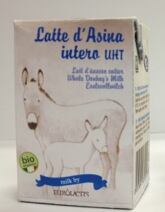Eurolactis, which was established in 2007, boasts the world’s only vertically-integrated supply chain focused on the production of donkey milk. It currently manages 910 donkeys through breeders in Italy – producing around 60,000 litres of donkey milk per year.
Until now, Eurolactis has focused on the manufacture of freeze-dried donkey milk powder.
In recent months, however, Eurolactis has completed the development of a process that preserves the nutritional benefits of donkey milk, while extending its shelf life to six months.
Eurolactis is yet to schedule a launch date for the product.
Speaking with DairyReporter.com earlier today, head of Eurolactis, Pierluigi Orunesu, heralded the company’s UHT innovation as the “next step” for the small donkey milk industry.
Tetra Pak UHT innovation “an industrial move”
“We are happy to announce that it is now possible to pack donkey milk into Tetra Pak cartons,” said Orunesu.
“This is an industrial move for the donkey milk sector,” said Orunesu. “Donkey milk is taking its next step in the market – no one has done this before.”
“We feel privileged to make donkey milk available in a Tetra Pak format – one that makes it ready to drink, and that preserves the fresh, sweet taste of donkey milk.”
Donkey milk has some unique nutritional characteristics that make it very similar to human breast milk, according to Eurolactis. It is high in vitamin C, contains up to four times less fat than other commercially available milk, as much as three times more omega 3, and it is naturally hypoallergenic.
Eurolactis has been able to preserve almost 100% of the nutrients found in raw donkey milk – even after ultra-high temperature (UHT) treatment.

“We are able to preserve around 95% of the nutrients found in fresh donkey milk – most importantly the protein content and the levels of polyunsaturated fatty acids,” said Orunesu.
No ‘mainstream’ ambitions for donkey milk
Eurolactis has already secured distribution agreements in Switzerland and Italy for the UHT innovation, and is currently negotiating the establishment of distribution channels in France, Northern Europe and China.
“We are making donkey milk more available to consumers,” said Orunesu.
He added, however, that the company has no ambitions to make donkey ‘mainstream’.
“In the coming future, donkey milk will find its right place in the market,” said Orunesu. “Our ambition isn’t for donkey milk to become a big dairy product. The potential for the donkey milk market is similar to buffalo milk. It is niche.”
“This innovation will be small in the dairy world, but a very large move in the donkey milk field,” Orunesu concluded.
